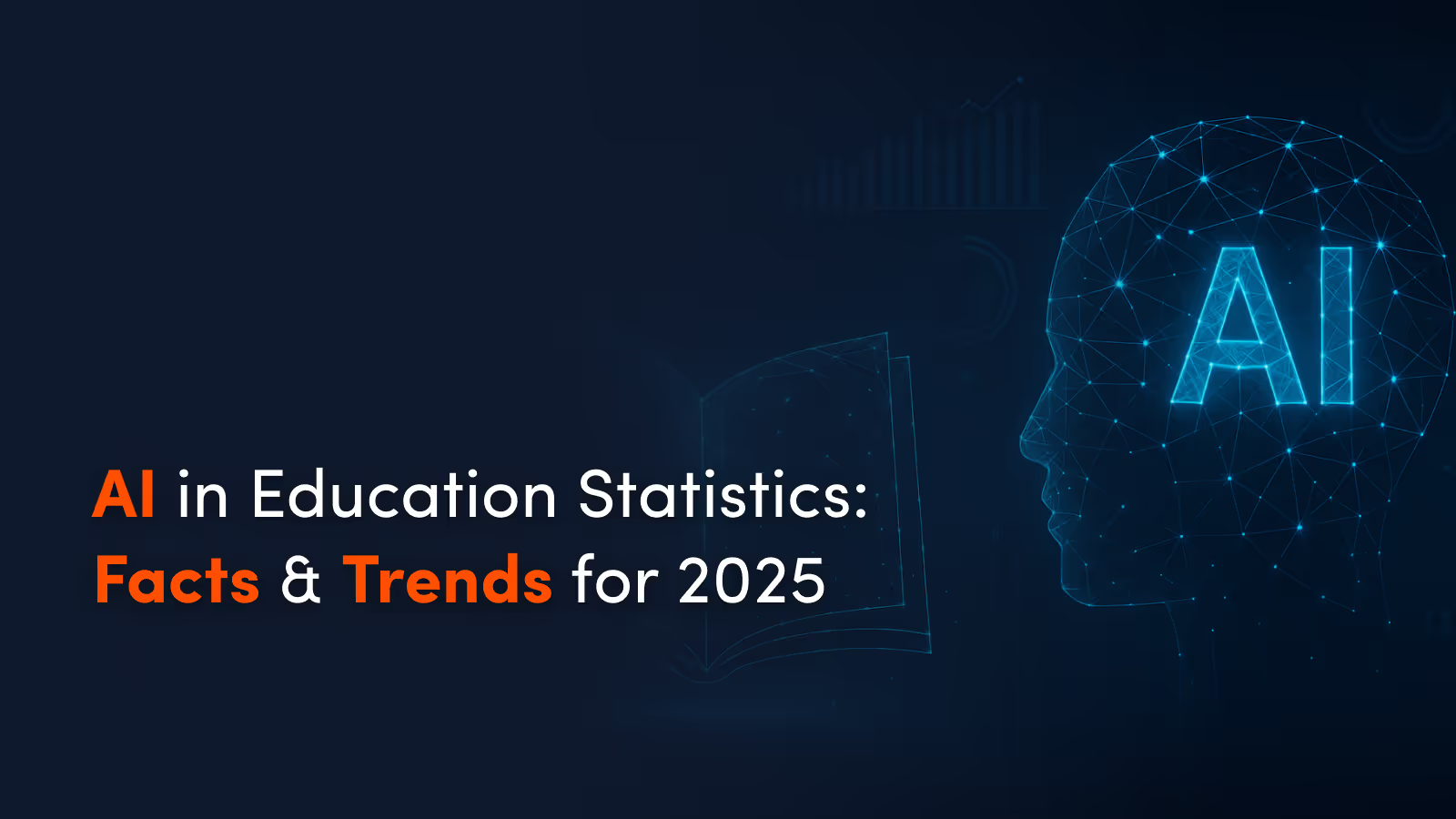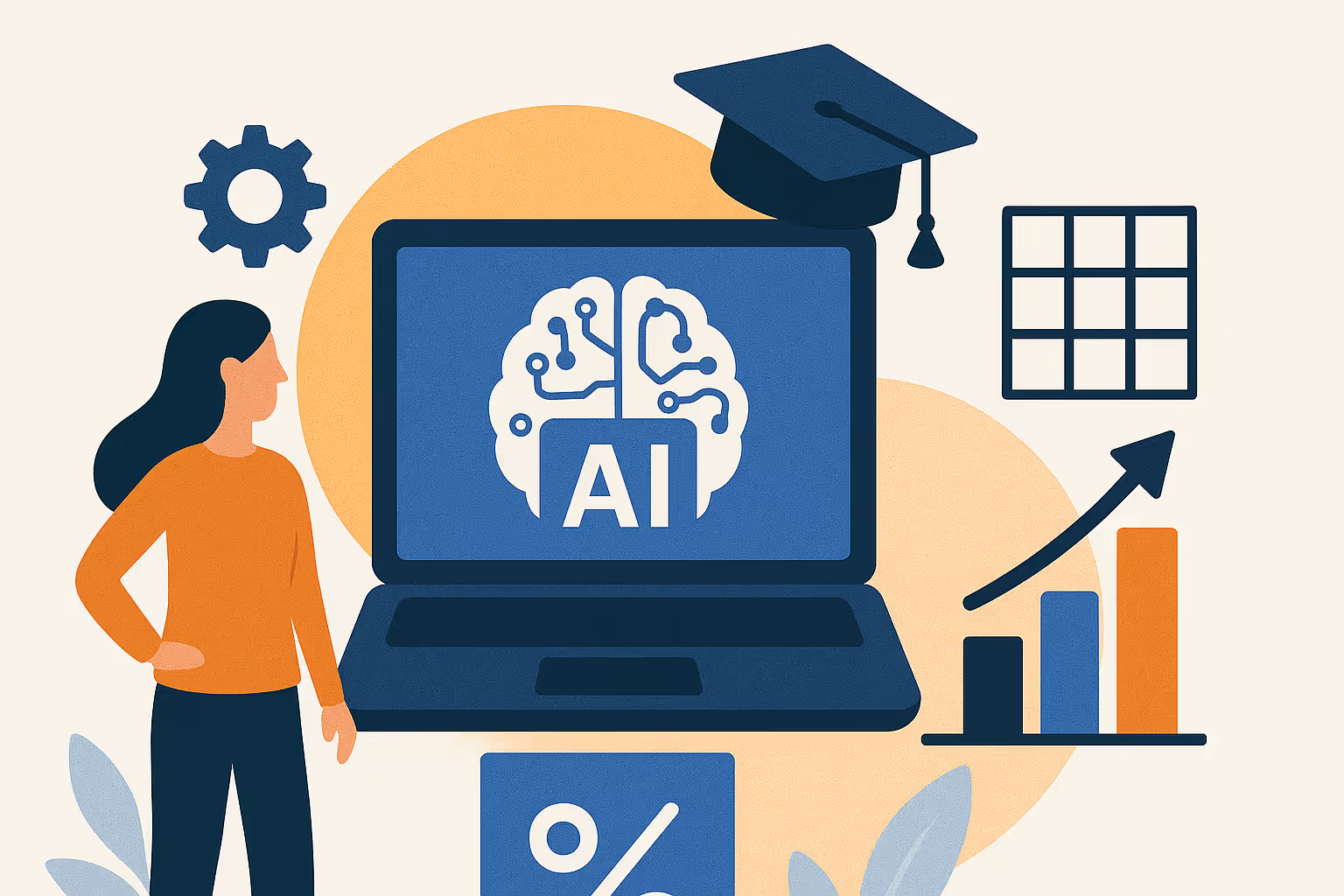About the Blog
AI in Education Statistics: Facts & Trends for 2025
Artificial intelligence is no longer a futuristic concept in education—it’s here, and it’s reshaping how we teach, learn, and manage institutions. From personalized learning to AI-powered grading tools, the adoption of artificial intelligence in education is accelerating fast. In this blog, we unpack the data behind AI’s growth in schools and universities, explore how educators feel about it and dive into both the benefits and concerns shaping the future of AI in education.
Key Takeaways
- The AI-powered EdTech market is booming, with billions in projected growth and widespread global adoption across K-12 and higher education.
- Teachers have mixed feelings about AI, embracing its benefits in personalization and automation while raising concerns about privacy, cost, and bias.
- AI is transforming learning through personalization, automation, and improved accessibility, especially for students with disabilities.
- Barriers like infrastructure, cost, and ethics must be addressed as AI tools become more embedded in educational systems worldwide.
The Growing Influence of AI in Education
Artificial intelligence is becoming a central force in reshaping the education landscape. From AI-powered tutoring systems to administrative automation, schools and universities are integrating AI tools at a rapid pace. Educators are exploring how these tools can reduce time-consuming tasks, personalize student learning, and support complex decision-making in classrooms and beyond.
This growing interest isn’t just anecdotal—it’s backed by investment and innovation. Institutions are increasingly allocating budgets toward AI initiatives, and EdTech startups are racing to deliver solutions that fit the evolving needs of 21st-century education.
As we look closer, the stats tell a powerful story: AI is making significant headway in both K-12 and higher education systems. Let’s dig into the numbers.
AI Statistics in Education
AI in education is scaling fast—and the data proves it. Despite a broader downgrade in global education spending, the global EdTech market is now projected to reach $404 billion by 2025, according to HolonIQ. This reflects a $63 billion increase over pre-COVID forecasts, representing a 16.3% compound annual growth rate (CAGR) and more than 2.5x growth from 2019 to 2025.
Countries leading the investment include the U.S., China, and the U.K., with AI being used across adaptive learning, administrative systems, and student engagement platforms. Tools like Gradescope, Khanmigo, and Duolingo Max demonstrate just how widespread and mainstream AI applications in education have become.
The demand for these tools continues to rise, especially in response to hybrid and remote learning trends that emerged during the pandemic and are now reshaping long-term strategy.
AI Implementation in Schools and Universities
AI isn’t just a higher ed trend. In K-12 education, AI is being used for everything from smart content curation to real-time tutoring.
What Are Teachers Saying About AI in Education?
Educators are both optimistic and cautious. Teachers using platforms like ChatGPT for lesson planning report time savings and improved lesson variety. Still, concerns persist around academic integrity, bias in algorithms, and a lack of clear guidelines on appropriate AI use in the classroom.
Real-world experiences vary widely. Some teachers report higher student engagement and better learning outcomes, while others highlight the need for ongoing professional development and ethical oversight to use AI responsibly.
Key Benefits of AI in Education
Personalized Learning and Student Engagement
AI allows learning to meet students where they are. Adaptive platforms like Khan Academy's Khanmigo adjust in real time to a learner’s strengths and weaknesses. Research from McKinsey indicates that personalized learning can improve student outcomes by up to 30%.
These tools empower students to learn at their own pace and revisit challenging concepts as needed. AI-driven tutors offer support on demand—creating an environment where learners feel supported, not just tested.
By engaging students more directly and giving immediate feedback, AI helps close gaps faster and promotes more effective, individualized instruction.
Automation in Teaching and Administrative Tasks
AI can handle time-consuming administrative work, giving teachers more bandwidth for instruction. Nearly 60 percent of U.S. principals reported using AI tools for their work.
AI chatbots are also answering student questions around the clock. For example, Element451’s AI agents are helping colleges automate responses to thousands of prospective student inquiries—from application deadlines to financial aid questions—instantly and accurately. This not only improves the student experience with 24/7 support but also frees up admissions staff to focus on more personalized outreach and strategic enrollment initiatives.
This automation extends to admissions, financial aid, and academic advising—streamlining workflows and making services more accessible to students.
Special Education and Accessibility
AI is enhancing accessibility for students with learning differences or disabilities. Tools like speech-to-text, real-time captioning, and personalized reading platforms help students engage in ways that suit their needs. Microsoft’s Immersive Reader, used in thousands of classrooms globally, helps students with dyslexia better process written text. AI’s ability to tailor content and support different learning modalities is transforming special education, creating more equitable experiences across the board.
Challenges and Concerns
Ethical and Privacy Concerns
AI’s expansion comes with legitimate concerns—chief among them, is data privacy. A Pew Research Center study found that 52% of Americans are more concerned than excited about AI in daily life, compared with just 10% who say they are more excited than concerned.
Teachers also worry about algorithmic bias. AI tools trained on limited or biased datasets can reinforce inequities instead of solving them. This is particularly risky when algorithms are used for decision-making in grading, admissions, or discipline.
Institutions need to ensure transparency and ethical AI usage by setting clear guidelines on data use, consent, and algorithmic fairness.
Cost and Infrastructure Barriers
AI adoption is expensive. According to a new UNESCO global survey of over 450 schools and universities found that fewer than 10% have developed institutional policies and/or formal guidance concerning the use of generative AI applications.
Even in developed regions, schools often struggle with budget constraints and insufficient training to use AI tools to their full potential. Without ongoing investment in both infrastructure and professional development, AI risks becoming a tool for the privileged, widening existing educational divides.
Addressing these issues requires not just funding but strategic planning to ensure AI tools are rolled out equitably and sustainably.
Where Is AI in Education Heading?
AI’s trajectory in education points toward smarter, more immersive experiences. Future innovations include AI-assisted assessments, virtual reality integration, and intelligent career counseling platforms that help students identify and prepare for career paths based on skills, interests, and labor trends.
Policy is also catching up. Education ministries and accrediting bodies are starting to roll out ethical frameworks and standards for responsible AI usage in classrooms, research, and student support services.
As AI becomes more embedded, expect to see an increased focus on AI literacy in curricula—ensuring students graduate not just with content knowledge but with an understanding of the tools shaping their futures.
Frequently Asked Questions
How can universities and educational institutions prepare students for careers in AI, automation, and advanced analytics?
By integrating AI and data literacy into coursework, offering experiential learning, and providing access to hands-on tools and industry collaborations.
Is the impact of AI in education positive or negative?
Largely positive when implemented thoughtfully, though it must be balanced with strong ethics, privacy protections, and equitable access.
Are universities taking measures to control AI usage?
Yes, many are implementing new policies, usage guidelines, and academic integrity standards to ensure responsible and fair use of AI tools.










